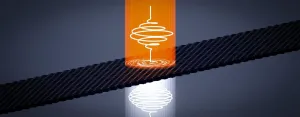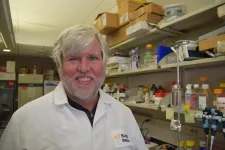(Press-News.org) Topological insulators are one of the most puzzling quantum materials - a class of materials whose electrons cooperate in surprising ways to produce unexpected properties. The edges of a TI are electron superhighways where electrons flow with no loss, ignoring any impurities or other obstacles in their path, while the bulk of the material blocks electron flow.
Scientists have studied these puzzling materials since their discovery just over a decade ago with an eye to harnessing them for things like quantum computing and information processing.
Now researchers at the Department of Energy's SLAC National Accelerator Laboratory and Stanford University have invented a new, hands-off way to probe the fastest and most ephemeral phenomena within a TI and clearly distinguish what its electrons are doing on the superhighway edges from what they're doing everywhere else.
The technique takes advantage of a phenomenon called high harmonic generation, or HHG, which shifts laser light to higher energies and higher frequencies - much like pressing a guitar string produces a higher note - by shining it through a material. By varying the polarization of laser light going into a TI and analyzing the shifted light coming out, researchers got strong and separate signals that told them what was happening in each of the material's two contrasting domains.
"What we found out is that the light coming out gives us information about the properties of the superhighway surfaces," said Shambhu Ghimire, a principal investigator with the Stanford PULSE Institute at SLAC, where the work was carried out. "This signal is quite remarkable, and its dependence on the polarization of the laser light is dramatically different from what we see in conventional materials. We think we have a potentially novel approach for initiating and probing quantum behaviors that are supposed to be present in a broad range of quantum materials."
The research team reported the results in Physical Review A today.
Light in, light out
Starting in 2010, a series of experiments led by Ghimire and PULSE Director David Reis showed HHG can be produced in ways that were previously thought unlikely or even impossible: by beaming laser light into a crystal, a frozen argon gas or an atomically thin semiconductor material. Another study described how to use HHG to generate attosecond laser pulses, which can be used to observe and control the movements of electrons, by shining a laser through ordinary glass.
In 2018, Denitsa Baykusheva, a Swiss National Science Foundation Fellow with a background in HHG research, joined the PULSE group as a postdoctoral researcher. Her goal was to study the potential for generating HHG in topological insulators - the first such study in a quantum material. "We wanted to see what happens to the intense laser pulse used to generate HHG," she said. "No one had actually focused such a strong laser light on these materials before."
But midway through those experiments, the COVID-19 pandemic hit and the lab shut down in March 2020 for all but essential research. So the team had to think of other ways to make progress, Baykusheva said.
"In a new area of research like this one, theory and experiment have to go hand in hand," she explained. "Theory is essential for explaining experimental results and also predicting the most promising avenues for future experiments. So we all turned ourselves into theorists" - first working with pen and paper and then writing code and doing calculations to feed into computer models.
An illuminating result
To their surprise, the results predicted that circularly polarized laser light, whose waves spiral around the beam like a corkscrew, could be used to trigger HHG in topological insulators.
"One of the interesting things we observed is that circularly polarized laser light is very efficient at generating harmonics from the superhighway surfaces of the topological insulator, but not from the rest of it," Baykusheva said. "This is something very unique and specific to this type of material. It can be used to get information about electrons that travel the superhighways and those that don't, and it can also be used to explore other types of materials that can't be probed with linearly polarized light."
The results lay out a recipe for continuing to explore HHG in quantum materials, said Reis, who is a co-author of the study.
"It's remarkable that a technique that generates strong and potentially disruptive fields, which takes electrons in the material and jostles them around and uses them to probe the properties of the material itself, can give you such a clear and robust signal about the material's topological states," he said.
"The fact that we can see anything at all is amazing, not to mention the fact that we could potentially use that same light to change the material's topological properties."
Experiments at SLAC have resumed on a limited basis, Reis added, and the results of the theoretical work have given the team new confidence that they know exactly what they are looking for.
INFORMATION:
Researchers from the Max Planck POSTECH/KOREA Research Initiative also contributed to this report. Major funding for the study came from the DOE Office of Science and the Swiss National Science Foundation.
Citation: Denitsa Baykusheva et al., Physical Review A, 2 February 2020
(10.1103/PhysRevA.103.023101)
SLAC is a vibrant multiprogram laboratory that explores how the universe works at the biggest, smallest and fastest scales and invents powerful tools used by scientists around the globe. With research spanning particle physics, astrophysics and cosmology, materials, chemistry, bio- and energy sciences and scientific computing, we help solve real-world problems and advance the interests of the nation.
SLAC is operated by Stanford University for the U.S. Department of Energy's Office of Science. The Office of Science is the single largest supporter of basic research in the physical sciences in the United States and is working to address some of the most pressing challenges of our time.
Ten months into COVID-19 living, people are adapting to speaking from behind, and understanding others who are wearing, a cloth face mask, University of California, Davis, researchers suggest in a new study.
Researchers in the Department of Linguistics at UC Davis and University of Wisconsin, Milwaukee, investigated how well speech is understood from those speaking while wearing a cloth mask. Due to social distancing measures, speakers for the study consisted of individuals from the same household, who recorded sentences while face-masked and non-face-masked. The researchers tested how well a separate group ...
New Haven, Conn. --A new study by Yale researchers found a significant association between the availability of hospital resources -- particularly ICU beds -- and patient mortality during the early weeks of the COVID-19 pandemic.
This was especially true at hospitals in the northeastern U.S. which were hardest hit by the first surge of patient cases, according to the study published in the Journal of Hospital Medicine.
"There is a general narrative among people in healthcare that the more resources there are, the better we can take care of patients," said lead author Dr. Alexander Janke, a Yale Emergency Scholar in the fourth year of a five-year combined residency and health services research fellowship. "This study begs ...
Many surgeries today are performed via minimally invasive procedures, in which a small incision is made and miniature cameras and surgical tools are threaded through the body to remove tumors and repair damaged tissues and organs. The process results in less pain and shorter recovery times compared to open surgery.
While many procedures can be performed in this way, surgeons can face challenges at an important step in the process: the sealing of internal wounds and tears.
Taking inspiration from origami, MIT engineers have now designed a medical patch that can be folded around minimally invasive surgical tools and delivered through airways, intestines, and other narrow spaces, to patch up internal injuries. ...
Interim analysis from phase 3 trial of nearly 20,000 participants suggests efficacy of two-dose regimen of the adenovirus-based vaccine is 91.6% against symptomatic COVID-19 - trial reports 16 COVID-19 cases in the vaccine group (0.1% [16/14,964) and 62 cases (1.3% [62/4,902]) in the placebo group.
No serious adverse events were deemed to be associated with vaccination, and most reported adverse events were mild, including flu-like symptoms, pain at injection site and weakness or low energy.
Sub-analysis of 2,000 adults older than 60 years suggests the vaccine is similarly effective and well tolerated in this group.
Trial is ongoing ...
JUPITER, FL - A collaboration led by Scripps Research has developed a way to separate the beneficial anti-inflammatory properties of a group of steroids called glucocorticoids from some of their unwanted side-effects, through an optimization process they named "ligand class analysis."
Their process enabled them to engineer two new, drug-like compounds that show steroidal anti-inflammatory action and other specific traits. One boosts muscle and energy supply, while the other reduces risk of muscle-wasting and bone loss typical of such drugs.
Their report, titled, "Chemical systems biology ...
TAMPA, Fla. -- Chimeric antigen receptor T-cell therapy, or CAR T, has been a breakthrough in the treatment of blood cancers such as acute lymphoblastic leukemia and diffuse large B-cell lymphoma. Clinical studies have shown overall response rates of more than 80% with an ongoing response of nearly 40% more than two years after therapy. However, the cellular immunotherapy doesn't work for every patient. Moffitt Cancer Center, one of the leading centers for cellular immunotherapy, is researching why some patients have a better CAR T response than others and what can be done to improve the treatment's effectiveness. In a new study ...
The many different sensations our bodies experience are accompanied by deeply complex exchanges of information within the brain, and the feeling of pain is no exception. So far, research has shown how pain intensity can be directly related to specific patterns of oscillation in brain activity, which are altered by the activation and deactivation of the 'interneurons' connecting different regions of the brain. However, it remains unclear how the process is affected by 'inhibitory' interneurons, which prevent chemical messages from passing between these regions. Through new research published in EPJ ...
Researchers developing renewable plastics and exploring new processes for plastics upcycling and recycling technologies will now be able to easily baseline their efforts to current manufacturing practices to understand if their efforts will save energy and reduce greenhouse gas emissions.
Benchmark data calculated and compiled at the National Renewable Energy Laboratory (NREL) provide a measurement--at the supply chain level--of how much energy is required and the amount of greenhouse gases emitted from the production of a variety of plastics in the United States.
"Today, we employ a predominantly linear economy for many of the materials we use, including plastics," said Gregg Beckham, a senior research fellow at NREL. "Many people ...
A soft, flexible sensor system created with electrically conductive yarns could help map problematic pressure points in the socket of an amputee's prosthetic limb, researchers from North Carolina State University report in a new study.
In IEEE Sensors Journal, researchers from North Carolina State University reported on the lightweight, soft textile-based sensor prototype patch. The device incorporates a lattice of conductive yarns and is connected to a tiny computer. They tested the system on a prosthetic limb and in walking experiments with two human volunteers, finding the system could ...
An international research team from the Photobiotechnology Research Group at Ruhr-Universität Bochum (RUB) led by Professor Thomas Happe and the Laboratoire de Bioénergétique et Ingénierie des Protéines (CNRS) in Marseille has been able to get to the bottom of this unique feature. They describe the molecular mechanism in Nature Communications on 2 February 2021.
Enzyme repeatedly survives the attack unharmed
Representatives of the [FeFe]-hydrogenase enzyme group combine protons and electrons to form molecular hydrogen at particularly high turnover rates. Some of them even use sunlight as a primary energy source ...


